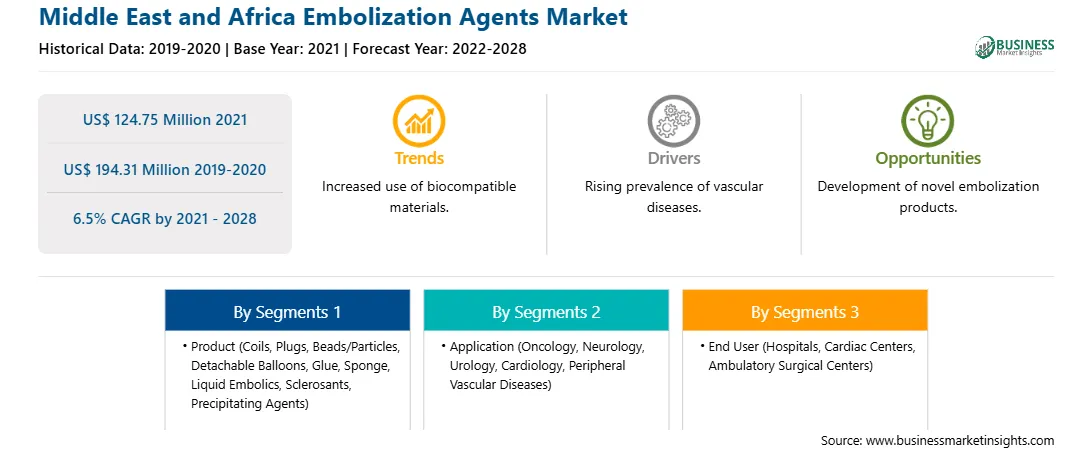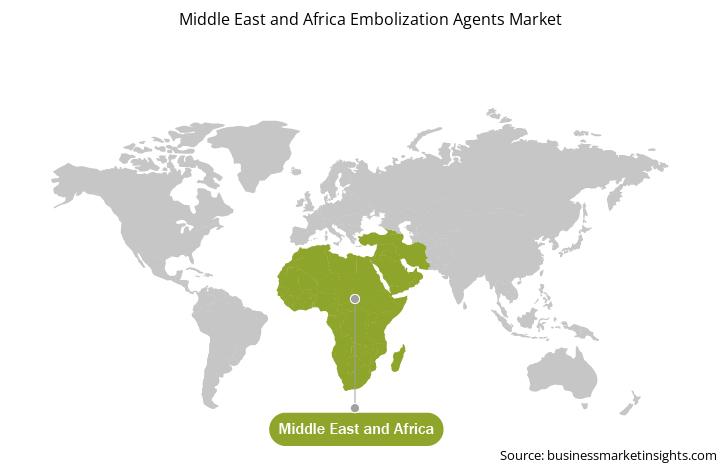Market Introduction
The Middle East & Africa embolization agents market is analyzed based on Saudi Arabia, UAE, South Africa, and the rest of Middle East & Africa. In the current market scenario, the Middle East region is experiencing increasing incidence of chronic diseases such as strokes, neurological disorders, cancer and rise in geriatric population, adapting unhealthy lifestyles. Moreover, acceptance and installations of modern technologies are projected to drive the market growth in this region. The key factors propelling the market include the rising incidences of chronic diseases and the aging population.
Rising risk factors such as obesity, high blood pressure, lack of physical activity, and smoking contribute to a rise in CVD cases. Cardiovascular diseases are the major cause of death, accounting for more than 45% of all deaths.
Saudi Arabia is experiencing significant change in the people’s standard of living and lifestyle; the changes have led to an increase in the consumption of fatty and poor-quality foods. The consequence of a changed lifestyle has resulted in the increasing rates of cardiovascular diseases. Another major factor increasing CVD cases in Saudi Arabia is the rising geriatric population. As per the Population Aging in Saudi Arabia report, the proportion of people in Saudi Arabia aged 60 or more is predicted to be 25% of the total population of 40 million by the end of 2050. Moreover, the number of people aged 80 or more is expected to reach 1.6 million, or 4% of the total population in the same period. In addition, the government is heavily investing in the construction of hospitals to build a strong healthcare sector in Saudi Arabia. For instance, in 2019, the Ministry of Health (MoH) planned to construct 35 hospitals all over the country. The improving healthcare expenditure and increasing government initiatives in Saudi Arabia are factors for the growth of the embolization agents market. As per the Gulf Cooperation Council (GCC), Saudi Arabia plans to invest SR250 billion ($66.67 billion) in healthcare infrastructure and boost private sector participation from the current 40 percent to 65 percent by 2030.
The healthcare sector in the UAE has undergone a considerable number of infrastructure and procedural changes to position itself as a leading healthcare provider. These improvements have attracted continuous investments for the improvement of hard and soft infrastructure during the COVID-19 pandemic. Due to COVID-19, a substantial number of planned elective surgery operations were cancelled or postponed in this region.
Since the beginning of 2020, the COVID-19 pandemic has caused enormous health and socioeconomic impacts, which are likely to continue in 2021 as well. The pandemic has caused disruptions in health services and has impacted the ability of countries to address and respond to noncommunicable diseases (NCDs). Moreover, economic uncertainties and ongoing conflicts are worsening the conditions in the Middle East and Africa. For instance, countries such as Syria, Libya, and Yemen are suffering violent conflict and have been unable to implement any public health measures; moreover, Iran was in a deep economic recession due to the US sanctions.
Strategic insights for the Middle East and Africa Embolization Agents provides data-driven analysis of the industry landscape, including current trends, key players, and regional nuances. These insights offer actionable recommendations, enabling readers to differentiate themselves from competitors by identifying untapped segments or developing unique value propositions. Leveraging data analytics, these insights help industry players anticipate the market shifts, whether investors, manufacturers, or other stakeholders. A future-oriented perspective is essential, helping stakeholders anticipate market shifts and position themselves for long-term success in this dynamic region. Ultimately, effective strategic insights empower readers to make informed decisions that drive profitability and achieve their business objectives within the market. The geographic scope of the Middle East and Africa Embolization Agents refers to the specific areas in which a business operates and competes. Understanding local distinctions, such as diverse consumer preferences (e.g., demand for specific plug types or battery backup durations), varying economic conditions, and regulatory environments, is crucial for tailoring strategies to specific markets. Businesses can expand their reach by identifying underserved areas or adapting their offerings to meet local demands. A clear market focus allows for more effective resource allocation, targeted marketing campaigns, and better positioning against local competitors, ultimately driving growth in those targeted areas.
Middle East and Africa Embolization Agents Strategic Insights

Middle East and Africa Embolization Agents Report Scope
Report Attribute
Details
Market size in 2021
US$ 124.75 Million
Market Size by 2028
US$ 194.31 Million
Global CAGR (2021 - 2028)
6.5%
Historical Data
2019-2020
Forecast period
2022-2028
Segments Covered
By Product
By Application
By End User
Regions and Countries Covered
Middle East and Africa
Market leaders and key company profiles
Middle East and Africa Embolization Agents Regional Insights

Market Overview and Dynamics
The embolization agents market in Middle East & Africa is expected to grow from US$ 124.75 million in 2021 to US$ 194.31 million by 2028; it is estimated to grow at a CAGR of 6.5% from 2021 to 2028. Surge in the Incidence of tumors and aneurysms; embolization agents are used to acutely stop the flow in a blood vessel or vascular territory by the means of mechanical occlusion. Embolization is a common procedure in interventional radiology. Embolizing agents like embolic microspheres (beads) are used to restrict the vascular supply of tumors and can be loaded with chemotherapeutic medicines, which elute and diffuse into the tissue. Liquid embolic agents are used to prevent blood supply to aneurysm or tumor. It helps in the prevention of aneurysms and tumors from growing and causing harm to essential organ. Thus, increasing prevalence of aneurysms and cancers is creating high demand for Middle East & Africa embolization agents market.
Key Market Segments
Based on product, the market is segmented into coils, beads/particles, plugs, detachable balloons, glue, sponge, liquid embolics, sclerosants, precipitating agents, others. The beads/particles segment held the largest share of the market in 2020. Based on coils the market is divided into detachable coils and pushable coils. The pushable coils segment held the largest share of the market in 2020. Based on beads/particles the market is divided into spherical and non-spherical. The pushable non-spherical segment held the largest share of the market in 2020. Based on application, the market is segmented into neurology, oncology, cardiology, peripheral vascular diseases, and others. In 2020, the oncology segment is likely to hold the largest share of the market. The embolization agents market by end user, is segmented into hospitals, ambulatory surgical centers, cardiac centers, and others. The hospitals segment held the largest share of the market in 2020.
Major Sources and Companies Listed
A few major primary and secondary sources referred to for preparing this report on the embolization agents market in Middle East & Africa are company websites, annual reports, financial reports, national government documents, and statistical database, among others. Major companies listed in the report are Abbott; Boston Scientific Corporation; Cook Medical LLC; DePuy Synthes; KANEKA CORPORATION; Medtronic; Merit Medical Systems Inc; Stryker Corporation; and Terumo Corporation among others.
Reasons to buy report
MIDDLE EAST & AFRICA EMBOLIZATION AGENTS MARKET SEGMENTATION
By Country
Company Profiles
The Middle East and Africa Embolization Agents Market is valued at US$ 124.75 Million in 2021, it is projected to reach US$ 194.31 Million by 2028.
As per our report Middle East and Africa Embolization Agents Market, the market size is valued at US$ 124.75 Million in 2021, projecting it to reach US$ 194.31 Million by 2028. This translates to a CAGR of approximately 6.5% during the forecast period.
The Middle East and Africa Embolization Agents Market report typically cover these key segments-
The historic period, base year, and forecast period can vary slightly depending on the specific market research report. However, for the Middle East and Africa Embolization Agents Market report:
The Middle East and Africa Embolization Agents Market is populated by several key players, each contributing to its growth and innovation. Some of the major players include:
The Middle East and Africa Embolization Agents Market report is valuable for diverse stakeholders, including:
Essentially, anyone involved in or considering involvement in the Middle East and Africa Embolization Agents Market value chain can benefit from the information contained in a comprehensive market report.